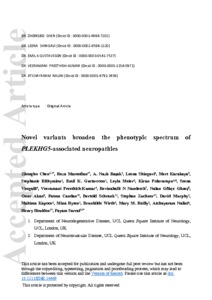Chen, Z;
Maroofian, R;
Başak, AN;
Shingavi, L;
Karakaya, M;
Efthymiou, S;
Gustavsson, EK;
Meier, L;
Polavarapu, K;
Vengalil, S;
et al.
Chen, Z; Maroofian, R; Başak, AN; Shingavi, L; Karakaya, M; Efthymiou, S; Gustavsson, EK; Meier, L; Polavarapu, K; Vengalil, S; Preethish-Kumar, V; Nandeesh, BN; Gökçe Güneş, N; Akan, O; Candan, F; Schrank, B; Zuchner, S; Murphy, D; Kapoor, M; Ryten, M; Wirth, B; Reilly, MM; Nalini, A; Houlden, H; Sarraf, P
(2021)
Novel variants broaden the phenotypic spectrum of PLEKHG5-associated neuropathies.
Eur J Neurol, 28 (4).
pp. 1344-1355.
ISSN 1468-1331
https://doi.org/10.1111/ene.14649
SGUL Authors: Maroofian, Reza
![[img]](https://openaccess.sgul.ac.uk/112664/1.hassmallThumbnailVersion/ene.14649.pdf)  Preview |
|
PDF
Accepted Version
Available under License ["licenses_description_publisher" not defined].
Download (13MB)
| Preview
|
Abstract
BACKGROUND: Pathogenic variants in PLEKHG5 have been reported, to date, to be causative in three unrelated families with autosomal recessive intermediate Charcot-Marie-Tooth disease (CMT) and in one consanguineous family with spinal muscular atrophy (SMA). PLEKHG5 is known to be expressed in the human peripheral nervous system and previous studies have shown its function in axon terminal autophagy of synaptic vesicles lending support to its underlying pathogenetic mechanism. Despite this, there is limited knowledge of the clinical and genetic spectrum of disease. METHODS: We leverage the diagnostic utility of exome and genome sequencing and describe novel biallelic variants in PLEKHG5 in thirteen individuals from nine unrelated families originating from four different countries. We compare our phenotypic and genotypic findings with a comprehensive review of cases previously described in the literature. RESULTS: We found that patients presented with variable disease severity at different ages of onset (8 to 25 years). In our cases, weakness usually started proximally, progressing distally, and can be associated with intermediate slow conduction velocities and minor clinical sensory involvement. We report three novel nonsense and four novel missense pathogenic variants associated with these PLEKHG5-associated neuropathies which are phenotypically SMA or intermediate CMT. CONCLUSIONS: Therefore, PLEKHG5-associated neuropathies should be considered as an important differential in non-5q SMAs even in the presence of mild sensory impairment and a candidate causative gene for a wide range of hereditary neuropathies. We present this series of cases to further the understanding of the phenotypic and molecular spectrum of PLEKHG5-associated diseases.
| Item Type: |
Article
|
| Additional Information: |
This is the peer reviewed version of the following article: Chen, Z., Maroofian, R., Başak, A.N., Shingavi, L., Karakaya, M., Efthymiou, S., Gustavsson, E.K., Meier, L., Polavarapu, K., Vengalil, S., Preethish‐Kumar, V., Nandeesh, B.N., Gökçe Güneş, N., Akan, O., Candan, F., Schrank, B., Zuchner, S., Murphy, D., Kapoor, M., Ryten, M., Wirth, B., Reilly, M.M., Nalini, A., Houlden, H. and Sarraf, P. (2021), Novel variants broaden the phenotypic spectrum of PLEKHG5‐associated neuropathies. Eur J Neurol, 28: 1344-1355, which has been published in final form at https://doi.org/10.1111/ene.14649. This article may be used for non-commercial purposes in accordance with Wiley Terms and Conditions for Use of Self-Archived Versions. |
| Keywords: |
Charcot-Marie-Tooth disease, genotype-phenotype association, hereditary motor neuropathy, hereditary sensory and motor neuropathy, peripheral nerve disease, spinal muscular atrophy, 1103 Clinical Sciences, 1109 Neurosciences, Neurology & Neurosurgery |
| SGUL Research Institute / Research Centre: |
Academic Structure > Molecular and Clinical Sciences Research Institute (MCS) |
| Journal or Publication Title: |
Eur J Neurol |
| ISSN: |
1468-1331 |
| Language: |
eng |
| Publisher License: |
Publisher's own licence |
| Projects: |
|
| PubMed ID: |
33220101 |
 |
Go to PubMed abstract |
| URI: |
https://openaccess.sgul.ac.uk/id/eprint/112664 |
| Publisher's version: |
https://doi.org/10.1111/ene.14649 |
Statistics
Item downloaded times since 30 Nov 2020.
Actions (login required)
 |
Edit Item |



